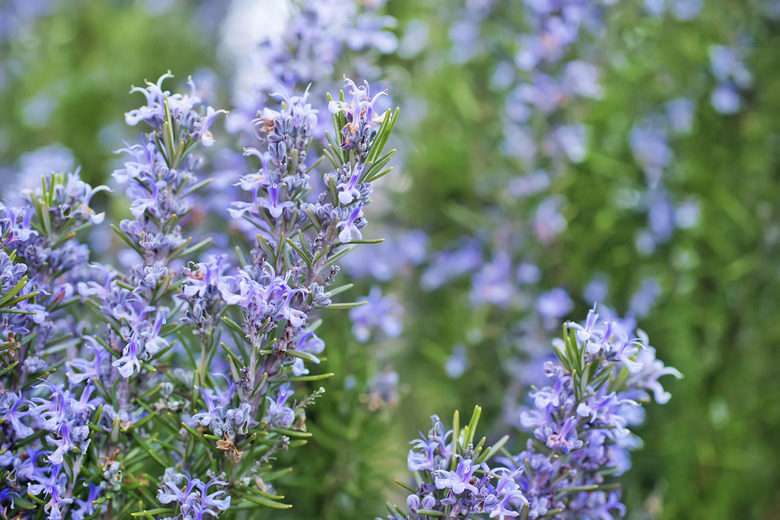How To Plant A Rosemary Hedge
Snacking on the landscaping might sound like something reserved for deer and rabbits. But plant a rosemary (Rosmarinus officinalis) hedge and you can harvest your landscaping for the kitchen — it's exceptional with lamb, beef and chicken but good with vegetables, too.
Snacking on the landscaping might sound like something reserved for deer and rabbits. But plant a rosemary (Rosmarinus officinalis) hedge and you can harvest your landscaping for the kitchen — it's exceptional with lamb, beef and chicken but good with vegetables, too. Rosemary tops out at about 6 feet tall depending on the cultivar, making it better suited as a low border than a privacy hedge. Rosemary is rabbit- and deer-tolerant. This woody perennial is an evergreen with delicate flowers in summer.
Selecting the Right Variety
Rosemary cultivars range from low-growing with a creeping habit, to 5-foot-tall shrubs. Taller varieties make the best hedges. "Tuscan Blue" (Rosmarinus officinalis "Tuscan Blue") grows up to 6 feet tall, which makes it a good choice for a large hedge. This cultivar, which grows in U.S. Department of Agriculture plant hardiness zones 8 through 11, is named for the tiny blue flowers that appear in summer.
- Snacking on the landscaping might sound like something reserved for deer and rabbits.
- Rosemary tops out at about 6 feet tall depending on the cultivar, making it better suited as a low border than a privacy hedge.
"Arp" (Rosmarinus officinalis "Arp") grows in USDA zones 7 through 11 — through it might be OK in USDA zone 6 — and gets between 3 and 6 feet tall.
The cultivar "Spice Islands" Rosmarinus officinalis ("Spice Islands") is both an exceptional culinary variety and a strong candidate for hedge planting. It grows 3 to 6 feet tall and grows in USDA zones 8 through 10.
Deciding When to Plant
In mild climates, late fall, winter and early spring are the most favorable planting seasons. The cool and rainy weather helps relieve stress and transplant shock. If it freezes in winter in your area, plant in fall or wait until spring.
Summer planting is more stressful, especially in hot climates but it can be done. Plant early in the morning or in the evening when the temperatures start to drop. If you can, pick an overcast day or couple of days to plant the hedge.
- "Arp" grows in USDA zones 7 through 11 — through it might be OK in USDA zone 6 — and gets between 3 and 6 feet tall.
Selecting and Preparing the Site
Rosemary must have good drainage, as it thrives in sandy and rocky soils and full sun. This Mediterranean native needs a minimum of six hours of sun per day and will take more if you've got it. In periodically wet areas with poor drainage or heavy clay soil, rosemary will grow poorly. In hot climates, rosemary tolerates afternoon shade.
Clear the area of weeds and large rocks before planting and then mix 1 to 3 inches of compost into the soil. Use seasoned compost. With a garden fork or tiller, thoroughly blend the compost with the soil along the length of the site of the intended hedge working it 3 to 4 inches deep in the soil.
Spacing and Planting
Space individual rosemary plants 3 feet apart to create a dense hedge. To make sure the hedge will look even, make sure the distance between the center of each hole is even. Use a string or other guide to make sure the plants will be in a straight line. Dig the planting holes so that they measure the same depth as the nursery pots are tall.
Getting the nursery plants out of their pots requires a delicate touch. Gently wiggle the roots free handing it by the base of the woody stem. Place each rosemary in a planting hole and add soil around the roots. It's critical the base of the stem sits level with the soil.
- Space individual rosemary plants 3 feet apart to create a dense hedge.
- Place each rosemary in a planting hole and add soil around the roots.
Water right after planting, soaking the soil until it is damp to the base of each root ball.
Watering the Hedge
Water is critical during the first season after planting while rosemary gets established. Water every five to seven days in dry weather. If the weather is damp, water when the top 2 to 3 inches of the soil starts to feel dry. To water, use a soaker setting or a soaker hose, supplying enough water to dampen the soil 5 to 6 inches deep. Established rosemary plants can tolerate some drought but maintaining a regular watering schedule will keep the hedge lush and green.
